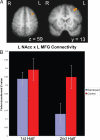Reduced capacity to sustain positive emotion in major depression reflects diminished maintenance of fronto-striatal brain activation
- PMID: 20080793
- PMCID: PMC2796908
- DOI: 10.1073/pnas.0910651106
Reduced capacity to sustain positive emotion in major depression reflects diminished maintenance of fronto-striatal brain activation
Abstract
Anhedonia, the loss of pleasure or interest in previously rewarding stimuli, is a core feature of major depression. While theorists have argued that anhedonia reflects a reduced capacity to experience pleasure, evidence is mixed as to whether anhedonia is caused by a reduction in hedonic capacity. An alternative explanation is that anhedonia is due to the inability to sustain positive affect across time. Using positive images, we used an emotion regulation task to test whether individuals with depression are unable to sustain activation in neural circuits underlying positive affect and reward. While up-regulating positive affect, depressed individuals failed to sustain nucleus accumbens activity over time compared with controls. This decreased capacity was related to individual differences in self-reported positive affect. Connectivity analyses further implicated the fronto-striatal network in anhedonia. These findings support the hypothesis that anhedonia in depressed patients reflects the inability to sustain engagement of structures involved in positive affect and reward.
Conflict of interest statement
Conflict of interest statement: N.H.K. is a consultant related to the development of psychotropic agents (or serves on the Scientific Advisory Board) for the following companies: Astra Zeneca, Bristol-Myers-Squibb, CeNeRx Biopharma, Corcept, Cyberonics, Forest Laboratories, General Electric Corp., Jazz Pharmaceuticals, Eli Lilly, Neuronetics, Sanofi Syntholabs, and Wyeth Pharmaceuticals (which funded this study). N.H.K. has stock options in Corcept and CeNeRx and is principal owner of Promoter Neurosciences.
Figures




References
-
- American Psychiatric Association. Diagnostic Criteria from DSM-IV-TR. Arlington, VA: Am Psychiatric Assoc; 2000. p. xii.
-
- Nestler EJ, Carlezon WA., Jr The mesolimbic dopamine reward circuit in depression. Biol Psychiatry. 2006;59:1151–1159. - PubMed
-
- Nestler EJ, et al. Neurobiology of depression. Neuron. 2002;34:13–25. - PubMed
-
- Tremblay LK, et al. Functional neuroanatomical substrates of altered reward processing in major depressive disorder revealed by a dopaminergic probe. Arch Gen Psychiatry. 2005;62:1228–1236. - PubMed
-
- Del Arco A, Mora F. Prefrontal cortex-nucleus accumbens interaction: In vivo modulation by dopamine and glutamate in the prefrontal cortex. Pharmacol Biochem Behav. 2008;90:226–235. - PubMed
Publication types
MeSH terms
Grants and funding
LinkOut - more resources
Full Text Sources
Medical

